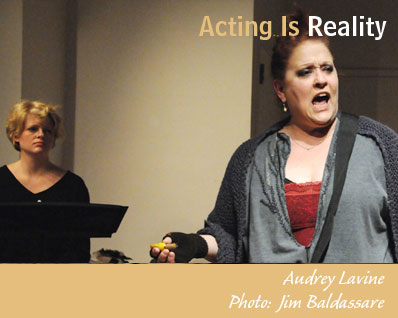In the Moscow Art Theatre every play acquired a carefully thought-out shape and a wealth of subtly elaborated detail. The one is useless without the other.
— Bertolt Brecht, 1952.
 John Rouse has suggested that focusing on “beats,” which Brecht called Einzelgeschehnissse (unique events), “allows an assimilation of Stanislavski’s acting methods to Brechtian interpretational ends.” Brecht did not encourage actors to connect the beats smoothly, however. Rather he regarded the transitions between beats as important as the beats themselves. Rouse notes Brecht actor Manfred Wekwerth’s observation that changes in personal and social forces bring about a change in the relationship between characters that in turn leads to one beat evolving into another.
John Rouse has suggested that focusing on “beats,” which Brecht called Einzelgeschehnissse (unique events), “allows an assimilation of Stanislavski’s acting methods to Brechtian interpretational ends.” Brecht did not encourage actors to connect the beats smoothly, however. Rather he regarded the transitions between beats as important as the beats themselves. Rouse notes Brecht actor Manfred Wekwerth’s observation that changes in personal and social forces bring about a change in the relationship between characters that in turn leads to one beat evolving into another.
Rehearsal recordings document Brecht’s great attention to detail in his actors’ development of characters. The actress Helene Weigel wrote about how her physical characterization of the lead role in The Mother grew out of giving the character one drooping shoulder. Angelika Hurwicz and other actors who worked with Brecht have testified as to his extraordinary attention to detail as a director:
With actors who fail to produce a certain nuance necessary at a key point in the plot, Brecht takes all possible measures to achieve the ends. He replaces emphasis by gesture, gesture by a pause, a look by a throat-clearing, and so on. In this way Brecht trains actors to be exact, to be responsible with regard to their parts and the whole play, without forcing them.
"With what was Lady Macbeth occupied at the culminating point of her tragedy?” Stanislavski asked. “The simple act of washing a spot of blood off her hand...." In An Actor Prepares he wrote:
We artists must realize the truth that even small physical movements, when injected into “given circumstances,” acquire great significance through their influence on emotion. The actual wiping off of the blood had helped Lady Macbeth to execute her ambitious designs. It is not by chance that all through the monologue you find in her memory the spot of blood recalled in connection with the murder of Duncan. A small physical act acquires en enormous inner meaning. The great inner struggle seeks an outlet in such an external act.
Brecht valued art as a source of detail for use in building characters. For instance, he recommended that actresses playing Grusha study Brueghel’s Dulle Griet.
Brecht’s attention to detail included psychological as well as behavioral components. For instance, Brecht wrote that a farmer in Caucasian Chalk Circle “is genuinely upset because a cheese, which in his opinion cannot taste good, is liked by all.” Similarly, he wrote that Grusha’s brother is “angry at his wife, the woman from Kulak, because he is dependent on her.” And again, of Mother Courage, he wrote:
She longs for the war but at the same time fears it. She wants to join in but as a peaceable business woman. She wants to maintain her family during the war and by means of it. She want to serve the army and also to keep out of its clutches.
While identifying such details, Brecht nonetheless recognized the need for characters to develop over the course of a play. “Grusha changes slowly, under the weight of sacrifices,” he wrote. Catching a fellow actor’s “tone” and “passing it on” allows “rhythms and cadence to develop through entire scenes.” It is “the story as a whole” that pulls the contradictions and “inconsistencies together,” Brecht wrote. “The ‘story’ is the theater’s great operation, the complete fitting together of all the gestic incidents, embracing the communications and impulses that must now to make up the audience’s entertainment.” This is analogous to Stanislavski’s “superobjective,” although possibly somewhat broader.
Stanislavksi described a successful actress who became interested in his system, and stopped working for several years to study it. She worked with a variety of teachers, but when she returned to the stage she was no longer successful. “The public found that she had lost her most valuable attribute, which was her direct outburst of inspiration,” Stanislavski wrote. This had been replaced with “naturalistic detail” After one performance Stanislavski reviewed her role with her in detail, and found that he approved of the preparation, her understanding of the role, and her physical technique. But she had failed to integrate the individual moments of her performance into a through-line, or whole. In simple language, she hadn’t discovered what the play was about for her or her character.
© H. Clark Kee, 2009
